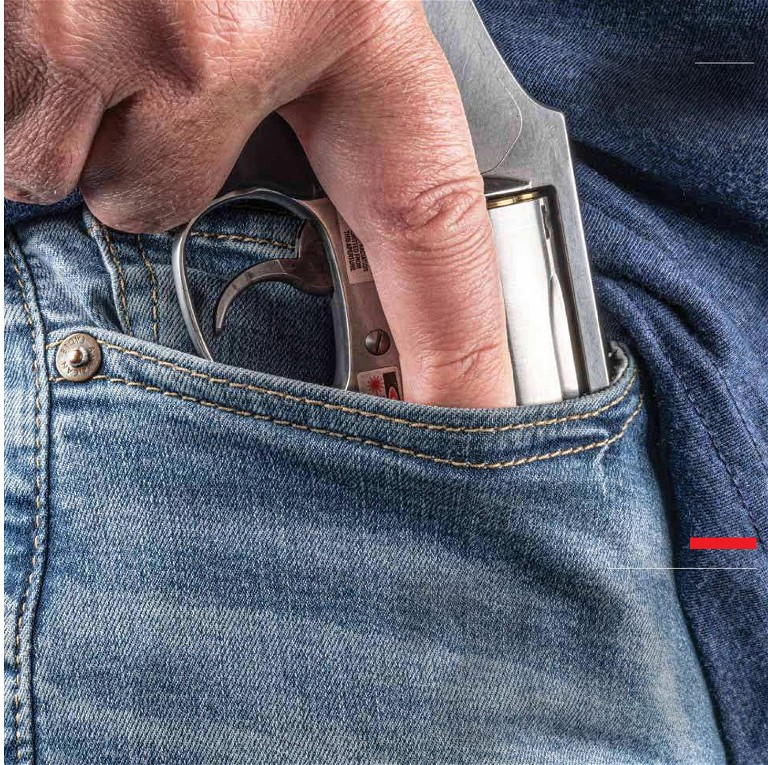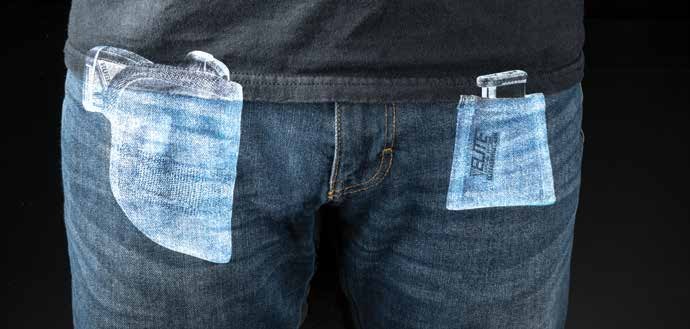BOB CAMPBELL
POCKET CARRY
THE FUNDAMENTALS

USE YOUR HEAD
Can you just jam any old pistol into any old pocket, as pictured here? Sure. But doing so is unsafe, and failure to employ the right equipment and techniques will drastically compromise both your performance and your ability to conceal the gun.
Pocket carry is among the most enduring types of concealed carry. Samuel Colt offered his popular pocket percussion pistols during the mid-19th century, followed by other manufacturers such as Iver Johnson and Smith & Wesson. In Arthur Conan Doyle’s The Hound of the Baskervilles (1902), the Victorian-era detective Sherlock Holmes asks Detective Inspector Greg Lestrade if he is armed.
“As long as I have my trousers I have a hip-pocket, and as long as I have my hip-pocket I have something in it,” Lestrade smiles.
Holmes replies, “Good! My friend [Dr. John Watson] and I are also ready for emergencies.” 1
While these characters and story are works of fiction, the scene demonstrates the main role of pocket carry in the 19th and early 20th centuries: that of an emergency backup plan. Even though technology has certainly evolved over the last 100-plus years, pocket carry still serves the same purpose. While it may seem like nothing more than dropping a handgun into your pocket, choosing to adopt this type of carry requires a basic knowledge of — and ardent adherence to — the fundamentals.
CARRY METHOD
As with every other decision in self-defense, you’re going to need to carefully weigh your options. The most efficient carry mode is a strong-side belt scabbard, but that requires a covering garment. The next best carry method is inside-the-waistband (IWB) carry. This requires only a light covering garment, since the majority of the handgun is concealed in the pants. Other carry modes that work well in certain circumstances are shoulder carry and cross-draw, but they also require substantial covering garments. Sometimes, pocket carry is the best way to go.
THE POCKET ITSELF
Your gun pocket should be free of keys, debris and any other material that might restrict your access to the firearm or cause a malfunction. I have seen one semi-automatic and one revolver tied up and rendered useless by material from a pocket. Worse yet, foreign items introduced to the gun pocket can induce a negligent discharge.
The style of your pocket determines how you will access your gun. Trouser pockets and exterior jacket pockets are usually side-loading. Jeans pockets, back pockets and interior jacket pockets are usually top-loading. Know your pockets — inside and out — because you will have to fit a holster not only to your gun but also to the pocket in which you intend to carry that gun.
THE GEAR
The holster (which is anything but optional for pocket carry) keeps the gun separated from dust and lint in the pocket and stabilizes the pistol for a sharp, repeatable draw. Some of the best holsters conceal the shape of the handgun, but whatever type or style it is, make sure the holster is securely in place and properly positioned.
Most pocket holsters, such as the DeSantis Nemesis, are ambidextrous.
Wright Leather Works also offers an excellent unit, the Insider, for pocket carry.
You must remember that other holster types are stabilized by the gun belt, but the pocket holster is not stabilized except by compression.
Gun selection will also play a major role. My favorite backup handgun is the snub-nosed .38 Special, but I would only consider a hammerless revolver (with the hammer entirely hidden by the frame) for pocket carry. The five-shot .38 is ideal, and Smith & Wesson, Ruger and Charter Arms all offer quality “hammerless” .38s.
There are plenty of quality striker-fired pistols without a protruding hammer as well, but whatever you opt for, a firearm without an external hammer is the best choice to achieve snag-free access.
THE DRAW
Pocket carry almost always incorporates a strong-side draw. When you begin, it is important to blade your hand into the pocket with your fingers extended.
This allows grasping the handgun and drawing smoothly. This may seem overtly and even comedically obvious, but you might be surprised how many carriers manage to get it wrong — especially those who’ve trained a bit in other modes of carry.

RIG UP RIGHT A quality pocke t holster and magazine carrier will keep both gun IfA quality pocket holster an you have practiced other types of and reload properly positioned for draws, then you have practiced grasping access during a crisis.
the pistol’s grip frame as soon as you make contact. But with pocket carry, if you make a fist inside of your pocket by immediately acquiring a firing grip, you will likely not be able to successfully draw without getting both your hand and gun caught. Instead, blade your hand in, grasp the grip frame without making a fist and, as the gun is drawn, only then affirm the firing grip. The holster will then either remain behind out of adhesion or will hook on some part of the pocket as you complete your draw. Train on this, as if you do not practice effectively clearing your holster, you will end up drawing both the handgun and the holster.
FAMILIARIZE YOURSELF
Pocket carry is useful but often misunderstood. Since almost everyone has experience with retrieving items from their pockets, all too many concealed carriers believe that drawing a firearm from a pocket is just as easy and that they can skip training on this style of going about armed. This is anything but true, and it can lead to everything from fumbling the draw to negligent discharges to being unable to draw when the gun is needed.
You won’t benefit from pocket carry if you don’t have a basic understanding of it and are not accustomed to doing it. Practice drawing the handgun from your pocket extensively before you trust a specific handgun-and-holster combination. This mode of carry is an important part of the overall self-defense picture and demands as much practice as any other type of carry despite its apparent simplicity.
ENDNOTES
(1) Arthur Conan Doyle, The Hound of the Baskervilles (New York: McClure, Phillip & Co., 1903), 218.
SOURCES DeSantis Gunhide: DeSantisHolster.com Wright
Leather Works: WrightLeatherWorks.com
THE TURBIAUX LE PROTECTOR
■ In 1882, French inventor Jacques Edmond Turbiaux patented the unique “Turbiaux Le Protector.” The nickel-plated pistol was designed to hold either 10 .22 rounds or seven 8mm rounds. The palm pistol could easily be concealed in the user’s hand since it was not much larger than a pocket watch. To open it, the user had to rotate the top plate until it released, exposing the revolving cylinder ring. The pistol was fired by pressing the trigger against the palm. Peter H. Finnegan, of the Minneapolis Firearms Co., licensed the design in the U.S. the following year. In 1892, Finnegan established the Chicago Fire Arms Co. and continued to produce Turbiaux’s pistol. Instead of firing the traditional .22 or 8mm rounds, Finnegan’s pistol fired seven .32 cartridges. The company advertised it as being compact, light, strong, quick, safe, effective and reliable. Finnegan contracted Ames Sword Co. to produce 15,000 of these pistols to sell at the 1893 Chicago World’s Fair, but it failed to fill the order in time, leading to a lawsuit between the two. The pistol remained in production until 1910.
— Frank Jastrzembski, Contributing Editor
